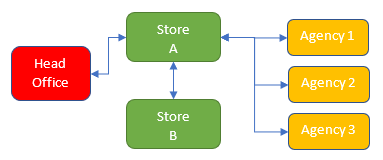 Library
Library
Pricing Overview
Fieldpine offers a wide variety of pricing options to suit many different retail requirements. Most retailers will only need a subset of the pricing options.
The main options are
- Unit Pricing.
- Pricemaps. Highly targetted individual price rules for a store, product, departmet, customer, within a date range.
- PriceGroups A set of pricing rules that are allocated to customers or stores. Customer/Stores can be added or removed easily from this allocation.
- Markdown Prices and labels a single product with a special price. Typically used for exception pricing, but does have other uses too
On this page: Common Pricing Situations | Pricing Options Explained | Worked Examples
Common Pricing Situations
Offer a single customer a special price for May
The special price will only apply for that narrow range of time.
Give selected cash customers a 20% discount in August
If you create a pricemap, setting it to 20% off, then add a 'trigger barcode', which is printed on the offer. Scanning this barcode will enable this price rule
Some customers should receive 'Trade Price'
Tip. You can create multiple Trade Price PriceGroups, perhaps a 10% group, and a 15% group for larger customers. You can then move customers between the groups easily.
I am a Franchisee with several agencies and want differing prices
Pricing Options Explained
Unit Pricing
The unit price, or ticket price, is the default "price" of the item if you could only put one price on it. This is the price you edit on the product page as the "price".
Pricemaps
Pricemaps are individual rules that can target one or more product, customer, department or store. When all these criteria are met the pricing rule is applied. The price rule can be either a setprice, or a discount from Unit Price.
- Able to have millions of rules defined.
- Easy to understand and implement if pricing being transferred in from other systems.
- Reporting is able to see each individual price rule being used
- Ideal for exception pricing, such as personalised customer contract pricing
PriceGroups
Pricegroups create a set of pricing rules, similar to a group of pricemaps, and then apply that group to customers or locations. This differs from pricemaps, which are allocated to a single customer or location. Read more
- Good for temporary specials, such as "Christmas Specials"
- Use for pricing that might be applied to multiple customers, such as "trade pricing"
Markdown Pricing
Creates a single price and prints a price label. The label is unique to a single product; if you markdown 3 items, you will get 3 seperate price labels.
- Creates a unique barcode and label.
- Intended for markdown/clearance stock, or "managers specials" concept
- POS measures time label printed and duration until sold, which can be used for pricing analysis (demand and price elasticity)
- Can be used for testing product placement effectiveness by using the time duration and determining which area of the store is more effective.
Worked Pricing Examples
Franchisee Overriding Prices for Agencies
Situation
A franchisee receives a product and pricing feed from Head Office. While franchisees are expected to sell at the head office price, this franchisee has a need to use different pricing on some products due to competitive pressure, higher freight costs or other reasons.

The franchisee operates from two stores and three agencies
The franchise feed arrives into Store A. The relationship between Head Office and Store A is "Multi Level"
Pricing is sent to store B as part of a "Chain of Stores" relationship; (Store A is now a head office itself and it controls Store B)
The data is sent to the agencies via a "Membership" or "Agency Profile"
Option 1
If the price changes are to apply to all stores and agencies, then simply edit the unitprice on each item in Store A. This will then override the price sent from head office and distribute that price to all stores and agencies. Any future pricing changes from head office will not be applied.
One disadvantage with this approach is that the inbound price from head office is overwritten. So if in future you change your mind and want one of the stores to use head office pricing, this wont be possible as those prices have been overridden. However it is easy to understand and manage.
Option 2
If there are only a few price changes, then create a pricemap for each product/store combination. These pricemaps will then override the head office price.
Create these pricemaps in Store A, if the pricing is for Store A, B or agencies.
Option 3
Create a PriceGroup in Store A. (more on Pricegroups) Allocate this pricegroup to the stores/agencies that should use this pricing. Then edit each product where the price is to differ and put the pricegroup price in.
When creating the pricegroup, you typically want an alternative priceband group that allows you to manually specify the price to charge.
Note, internally pricegroups are typically implemented as pricemaps on your behalf, but the system treats all the pricing as a group so that you manage the group rather than each individual pricemap
Option 4
If the pricing only applies to a single agency, then that agency can edit the unit price (as Option 1) and affect their own pricing, or create pricemps (Option 2) and treat them as exceptions
Within Fieldpine, an agency store is a separate Fieldpine system able to control their own operation. Assuming you have given the agency login passwords.
Exceptions & Notes
If you use a pricegroup and assign this to three stores/agencies (option 3), but then need to change the price of a couple of items for one store, you can create a pricemap for those exceptions. The only trick benig that the "priority" field on the pricemap itself must be higher than the priority on the pricegroup
Pricemaps and Pricegroups need to be enabled to send/load across a store/agency boundary